Leadership Strategies for Collaboration, Empowerment, and Governance
VerifiedAdded on 2021/06/15
|6
|1140
|27
Essay
AI Summary
This essay delves into the crucial aspects of collaboration, empowerment, and governance in leadership, particularly within the healthcare sector. It highlights the significance of fostering a collaborative environment, promoting teamwork through cross-functional teams, and facilitating consistent communication using advanced technology. The essay emphasizes the importance of utilizing the right tools and identifying collaborative leaders, such as managers, to drive project success. Furthermore, it outlines the principles of effective leadership, including motivating employees, providing feedback, and maintaining accountability by setting clear milestones. The continuous improvement process is also stressed as a key element in enhancing internal processes and services. The document concludes by underscoring the significance of accountability in leadership, which empowers individuals to perform efficiently and achieve expected standards. The essay references several scholarly articles to support its arguments and provide a comprehensive analysis of the subject matter.
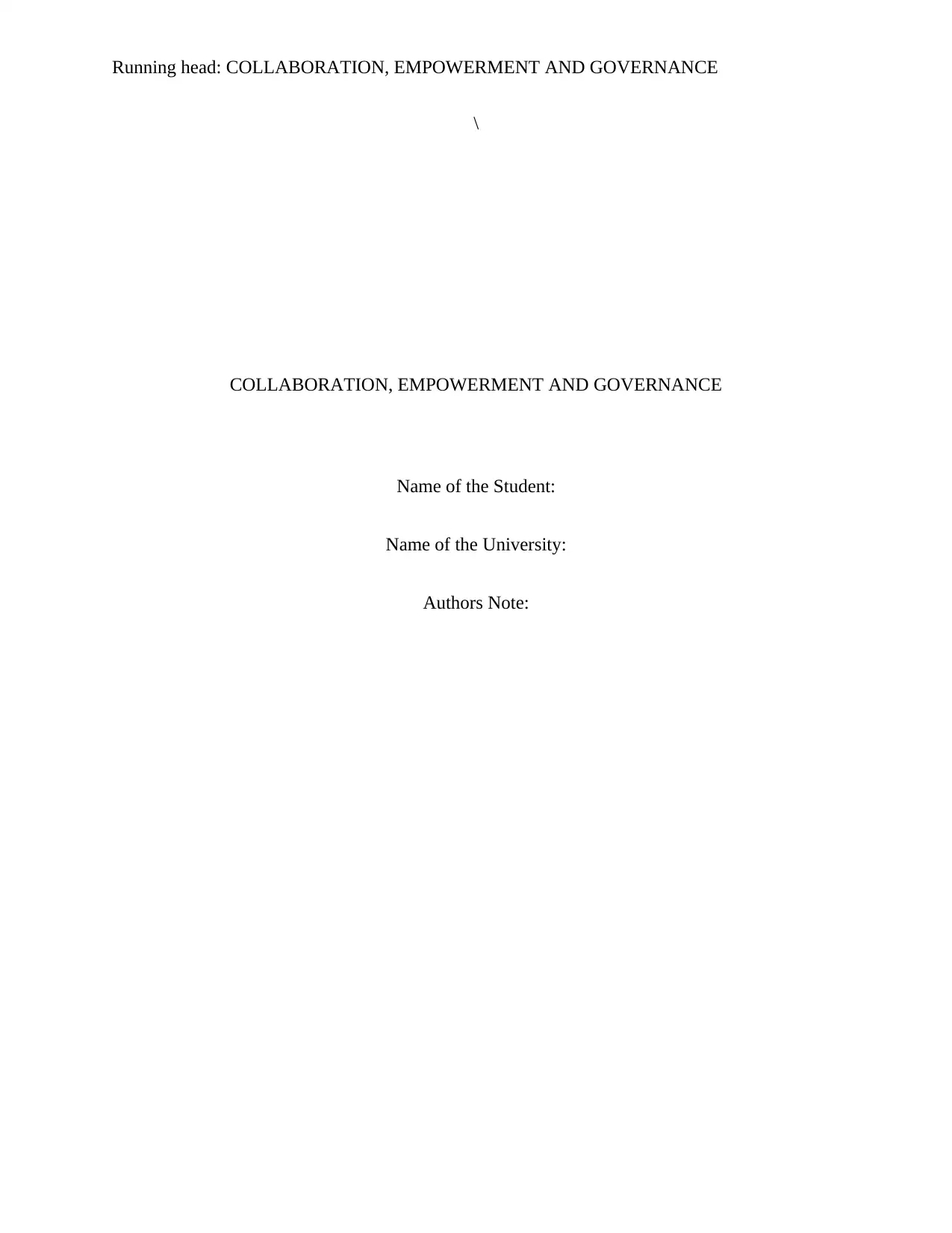
Running head: COLLABORATION, EMPOWERMENT AND GOVERNANCE
\
COLLABORATION, EMPOWERMENT AND GOVERNANCE
Name of the Student:
Name of the University:
Authors Note:
\
COLLABORATION, EMPOWERMENT AND GOVERNANCE
Name of the Student:
Name of the University:
Authors Note:
Paraphrase This Document
Need a fresh take? Get an instant paraphrase of this document with our AI Paraphraser
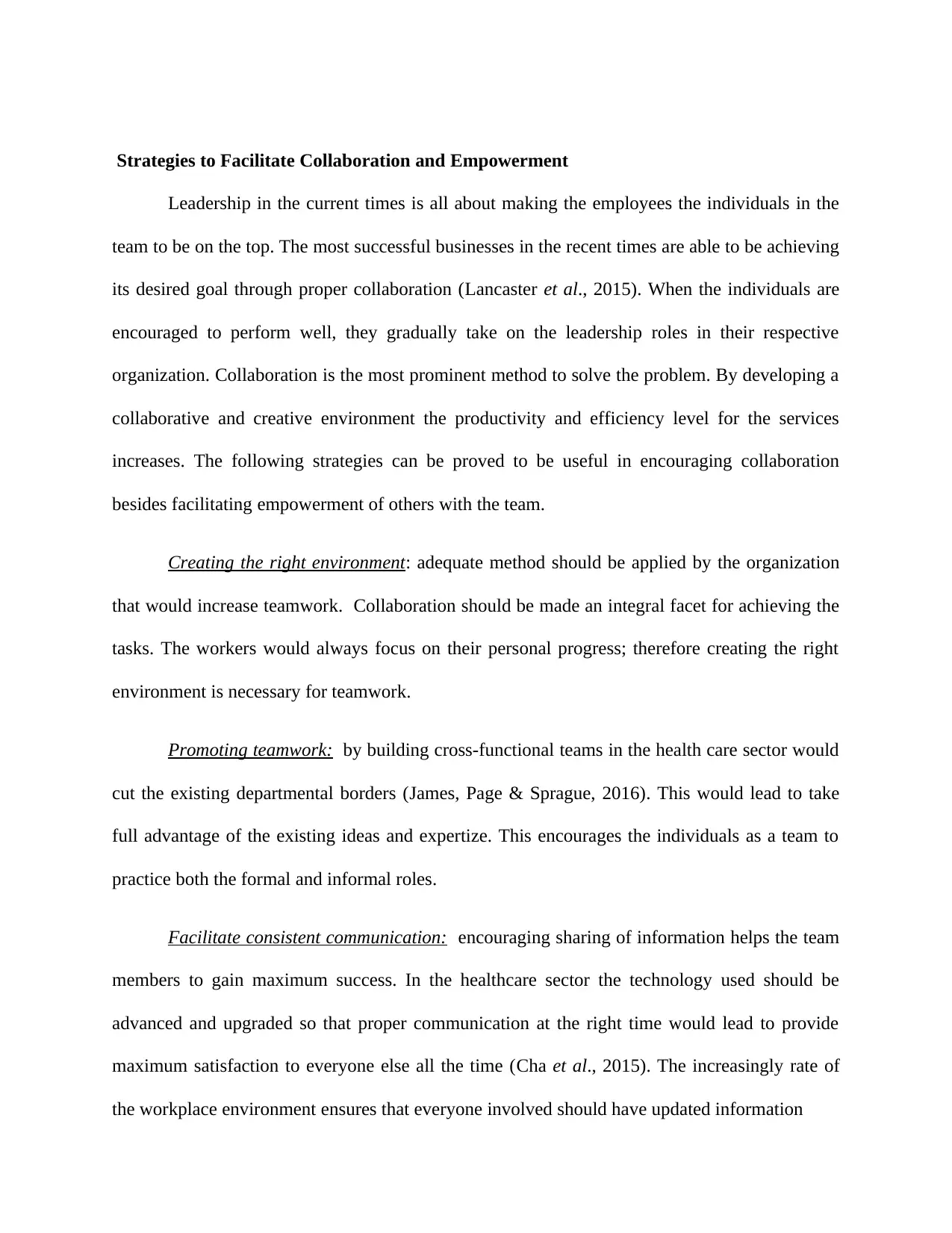
Strategies to Facilitate Collaboration and Empowerment
Leadership in the current times is all about making the employees the individuals in the
team to be on the top. The most successful businesses in the recent times are able to be achieving
its desired goal through proper collaboration (Lancaster et al., 2015). When the individuals are
encouraged to perform well, they gradually take on the leadership roles in their respective
organization. Collaboration is the most prominent method to solve the problem. By developing a
collaborative and creative environment the productivity and efficiency level for the services
increases. The following strategies can be proved to be useful in encouraging collaboration
besides facilitating empowerment of others with the team.
Creating the right environment: adequate method should be applied by the organization
that would increase teamwork. Collaboration should be made an integral facet for achieving the
tasks. The workers would always focus on their personal progress; therefore creating the right
environment is necessary for teamwork.
Promoting teamwork: by building cross-functional teams in the health care sector would
cut the existing departmental borders (James, Page & Sprague, 2016). This would lead to take
full advantage of the existing ideas and expertize. This encourages the individuals as a team to
practice both the formal and informal roles.
Facilitate consistent communication: encouraging sharing of information helps the team
members to gain maximum success. In the healthcare sector the technology used should be
advanced and upgraded so that proper communication at the right time would lead to provide
maximum satisfaction to everyone else all the time (Cha et al., 2015). The increasingly rate of
the workplace environment ensures that everyone involved should have updated information
Leadership in the current times is all about making the employees the individuals in the
team to be on the top. The most successful businesses in the recent times are able to be achieving
its desired goal through proper collaboration (Lancaster et al., 2015). When the individuals are
encouraged to perform well, they gradually take on the leadership roles in their respective
organization. Collaboration is the most prominent method to solve the problem. By developing a
collaborative and creative environment the productivity and efficiency level for the services
increases. The following strategies can be proved to be useful in encouraging collaboration
besides facilitating empowerment of others with the team.
Creating the right environment: adequate method should be applied by the organization
that would increase teamwork. Collaboration should be made an integral facet for achieving the
tasks. The workers would always focus on their personal progress; therefore creating the right
environment is necessary for teamwork.
Promoting teamwork: by building cross-functional teams in the health care sector would
cut the existing departmental borders (James, Page & Sprague, 2016). This would lead to take
full advantage of the existing ideas and expertize. This encourages the individuals as a team to
practice both the formal and informal roles.
Facilitate consistent communication: encouraging sharing of information helps the team
members to gain maximum success. In the healthcare sector the technology used should be
advanced and upgraded so that proper communication at the right time would lead to provide
maximum satisfaction to everyone else all the time (Cha et al., 2015). The increasingly rate of
the workplace environment ensures that everyone involved should have updated information
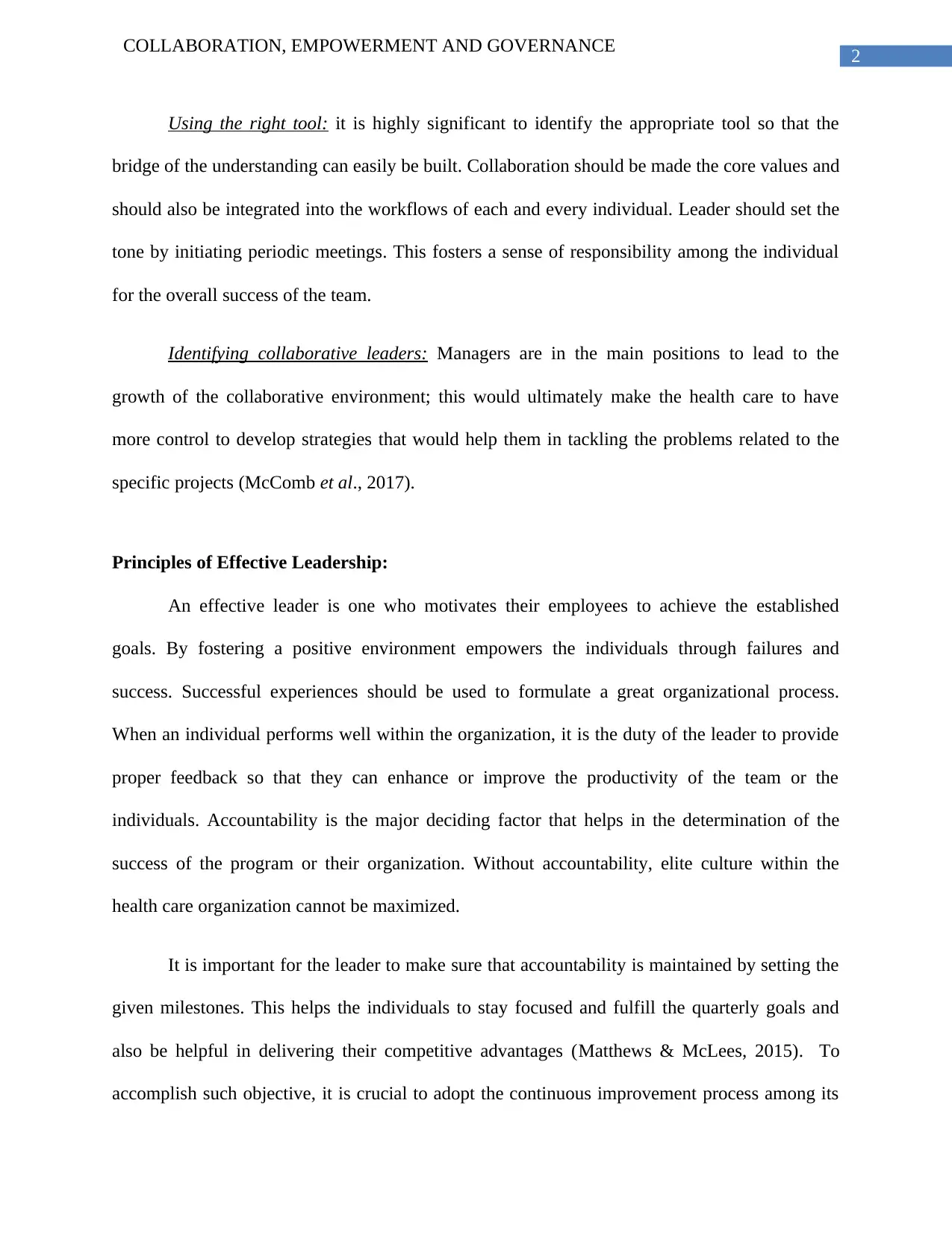
2
COLLABORATION, EMPOWERMENT AND GOVERNANCE
Using the right tool: it is highly significant to identify the appropriate tool so that the
bridge of the understanding can easily be built. Collaboration should be made the core values and
should also be integrated into the workflows of each and every individual. Leader should set the
tone by initiating periodic meetings. This fosters a sense of responsibility among the individual
for the overall success of the team.
Identifying collaborative leaders: Managers are in the main positions to lead to the
growth of the collaborative environment; this would ultimately make the health care to have
more control to develop strategies that would help them in tackling the problems related to the
specific projects (McComb et al., 2017).
Principles of Effective Leadership:
An effective leader is one who motivates their employees to achieve the established
goals. By fostering a positive environment empowers the individuals through failures and
success. Successful experiences should be used to formulate a great organizational process.
When an individual performs well within the organization, it is the duty of the leader to provide
proper feedback so that they can enhance or improve the productivity of the team or the
individuals. Accountability is the major deciding factor that helps in the determination of the
success of the program or their organization. Without accountability, elite culture within the
health care organization cannot be maximized.
It is important for the leader to make sure that accountability is maintained by setting the
given milestones. This helps the individuals to stay focused and fulfill the quarterly goals and
also be helpful in delivering their competitive advantages (Matthews & McLees, 2015). To
accomplish such objective, it is crucial to adopt the continuous improvement process among its
COLLABORATION, EMPOWERMENT AND GOVERNANCE
Using the right tool: it is highly significant to identify the appropriate tool so that the
bridge of the understanding can easily be built. Collaboration should be made the core values and
should also be integrated into the workflows of each and every individual. Leader should set the
tone by initiating periodic meetings. This fosters a sense of responsibility among the individual
for the overall success of the team.
Identifying collaborative leaders: Managers are in the main positions to lead to the
growth of the collaborative environment; this would ultimately make the health care to have
more control to develop strategies that would help them in tackling the problems related to the
specific projects (McComb et al., 2017).
Principles of Effective Leadership:
An effective leader is one who motivates their employees to achieve the established
goals. By fostering a positive environment empowers the individuals through failures and
success. Successful experiences should be used to formulate a great organizational process.
When an individual performs well within the organization, it is the duty of the leader to provide
proper feedback so that they can enhance or improve the productivity of the team or the
individuals. Accountability is the major deciding factor that helps in the determination of the
success of the program or their organization. Without accountability, elite culture within the
health care organization cannot be maximized.
It is important for the leader to make sure that accountability is maintained by setting the
given milestones. This helps the individuals to stay focused and fulfill the quarterly goals and
also be helpful in delivering their competitive advantages (Matthews & McLees, 2015). To
accomplish such objective, it is crucial to adopt the continuous improvement process among its
⊘ This is a preview!⊘
Do you want full access?
Subscribe today to unlock all pages.

Trusted by 1+ million students worldwide
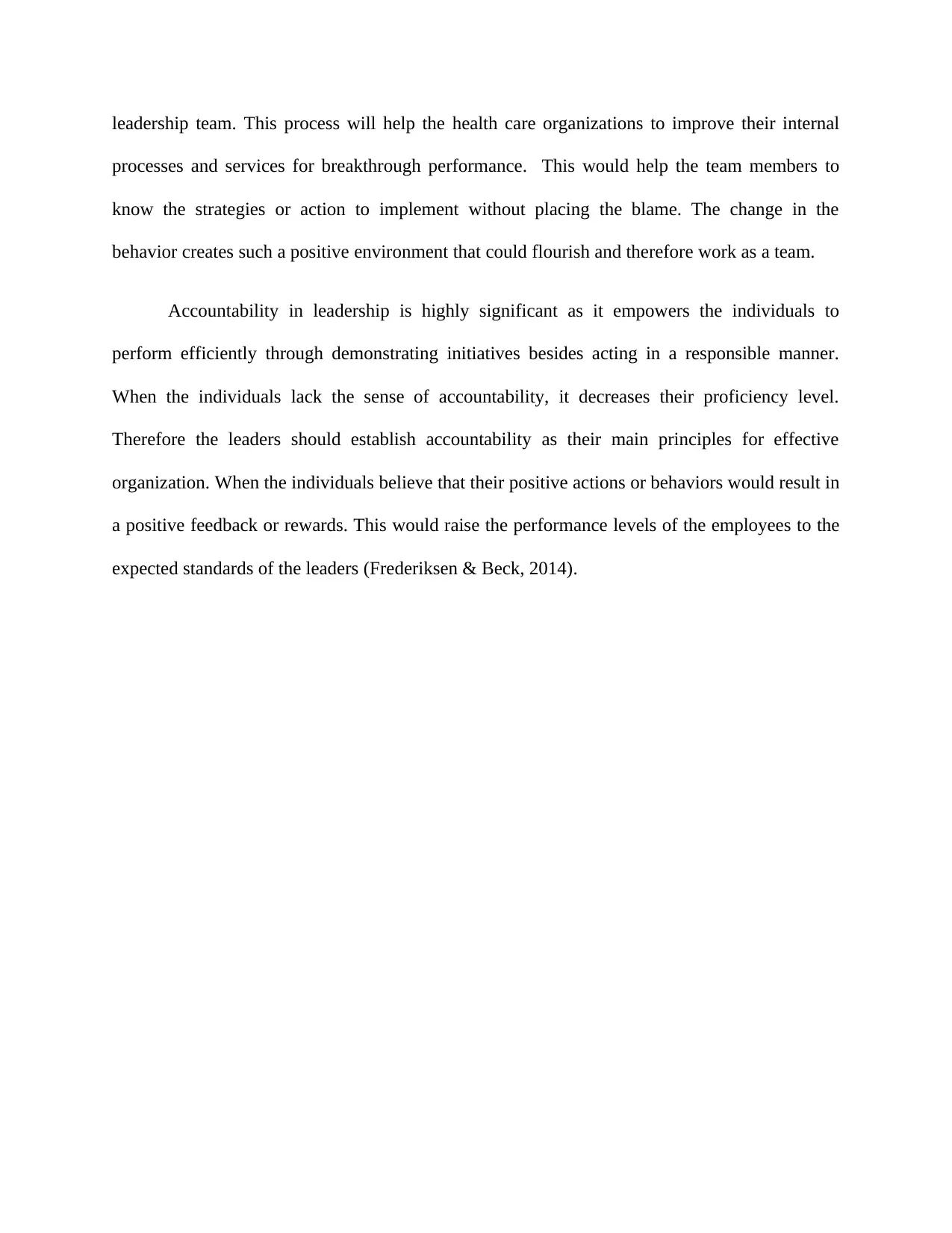
leadership team. This process will help the health care organizations to improve their internal
processes and services for breakthrough performance. This would help the team members to
know the strategies or action to implement without placing the blame. The change in the
behavior creates such a positive environment that could flourish and therefore work as a team.
Accountability in leadership is highly significant as it empowers the individuals to
perform efficiently through demonstrating initiatives besides acting in a responsible manner.
When the individuals lack the sense of accountability, it decreases their proficiency level.
Therefore the leaders should establish accountability as their main principles for effective
organization. When the individuals believe that their positive actions or behaviors would result in
a positive feedback or rewards. This would raise the performance levels of the employees to the
expected standards of the leaders (Frederiksen & Beck, 2014).
processes and services for breakthrough performance. This would help the team members to
know the strategies or action to implement without placing the blame. The change in the
behavior creates such a positive environment that could flourish and therefore work as a team.
Accountability in leadership is highly significant as it empowers the individuals to
perform efficiently through demonstrating initiatives besides acting in a responsible manner.
When the individuals lack the sense of accountability, it decreases their proficiency level.
Therefore the leaders should establish accountability as their main principles for effective
organization. When the individuals believe that their positive actions or behaviors would result in
a positive feedback or rewards. This would raise the performance levels of the employees to the
expected standards of the leaders (Frederiksen & Beck, 2014).
Paraphrase This Document
Need a fresh take? Get an instant paraphrase of this document with our AI Paraphraser
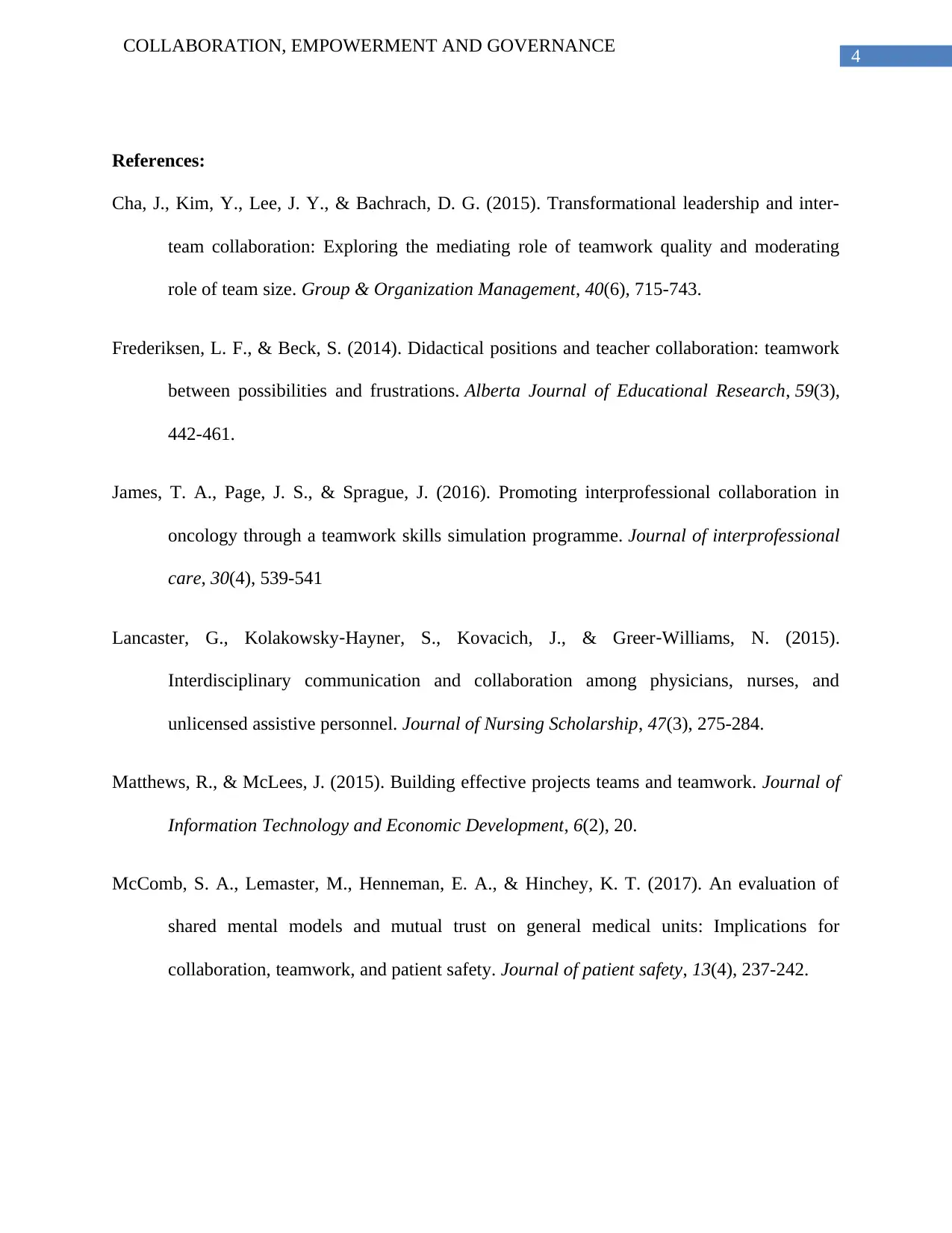
4
COLLABORATION, EMPOWERMENT AND GOVERNANCE
References:
Cha, J., Kim, Y., Lee, J. Y., & Bachrach, D. G. (2015). Transformational leadership and inter-
team collaboration: Exploring the mediating role of teamwork quality and moderating
role of team size. Group & Organization Management, 40(6), 715-743.
Frederiksen, L. F., & Beck, S. (2014). Didactical positions and teacher collaboration: teamwork
between possibilities and frustrations. Alberta Journal of Educational Research, 59(3),
442-461.
James, T. A., Page, J. S., & Sprague, J. (2016). Promoting interprofessional collaboration in
oncology through a teamwork skills simulation programme. Journal of interprofessional
care, 30(4), 539-541
Lancaster, G., Kolakowsky‐Hayner, S., Kovacich, J., & Greer‐Williams, N. (2015).
Interdisciplinary communication and collaboration among physicians, nurses, and
unlicensed assistive personnel. Journal of Nursing Scholarship, 47(3), 275-284.
Matthews, R., & McLees, J. (2015). Building effective projects teams and teamwork. Journal of
Information Technology and Economic Development, 6(2), 20.
McComb, S. A., Lemaster, M., Henneman, E. A., & Hinchey, K. T. (2017). An evaluation of
shared mental models and mutual trust on general medical units: Implications for
collaboration, teamwork, and patient safety. Journal of patient safety, 13(4), 237-242.
COLLABORATION, EMPOWERMENT AND GOVERNANCE
References:
Cha, J., Kim, Y., Lee, J. Y., & Bachrach, D. G. (2015). Transformational leadership and inter-
team collaboration: Exploring the mediating role of teamwork quality and moderating
role of team size. Group & Organization Management, 40(6), 715-743.
Frederiksen, L. F., & Beck, S. (2014). Didactical positions and teacher collaboration: teamwork
between possibilities and frustrations. Alberta Journal of Educational Research, 59(3),
442-461.
James, T. A., Page, J. S., & Sprague, J. (2016). Promoting interprofessional collaboration in
oncology through a teamwork skills simulation programme. Journal of interprofessional
care, 30(4), 539-541
Lancaster, G., Kolakowsky‐Hayner, S., Kovacich, J., & Greer‐Williams, N. (2015).
Interdisciplinary communication and collaboration among physicians, nurses, and
unlicensed assistive personnel. Journal of Nursing Scholarship, 47(3), 275-284.
Matthews, R., & McLees, J. (2015). Building effective projects teams and teamwork. Journal of
Information Technology and Economic Development, 6(2), 20.
McComb, S. A., Lemaster, M., Henneman, E. A., & Hinchey, K. T. (2017). An evaluation of
shared mental models and mutual trust on general medical units: Implications for
collaboration, teamwork, and patient safety. Journal of patient safety, 13(4), 237-242.
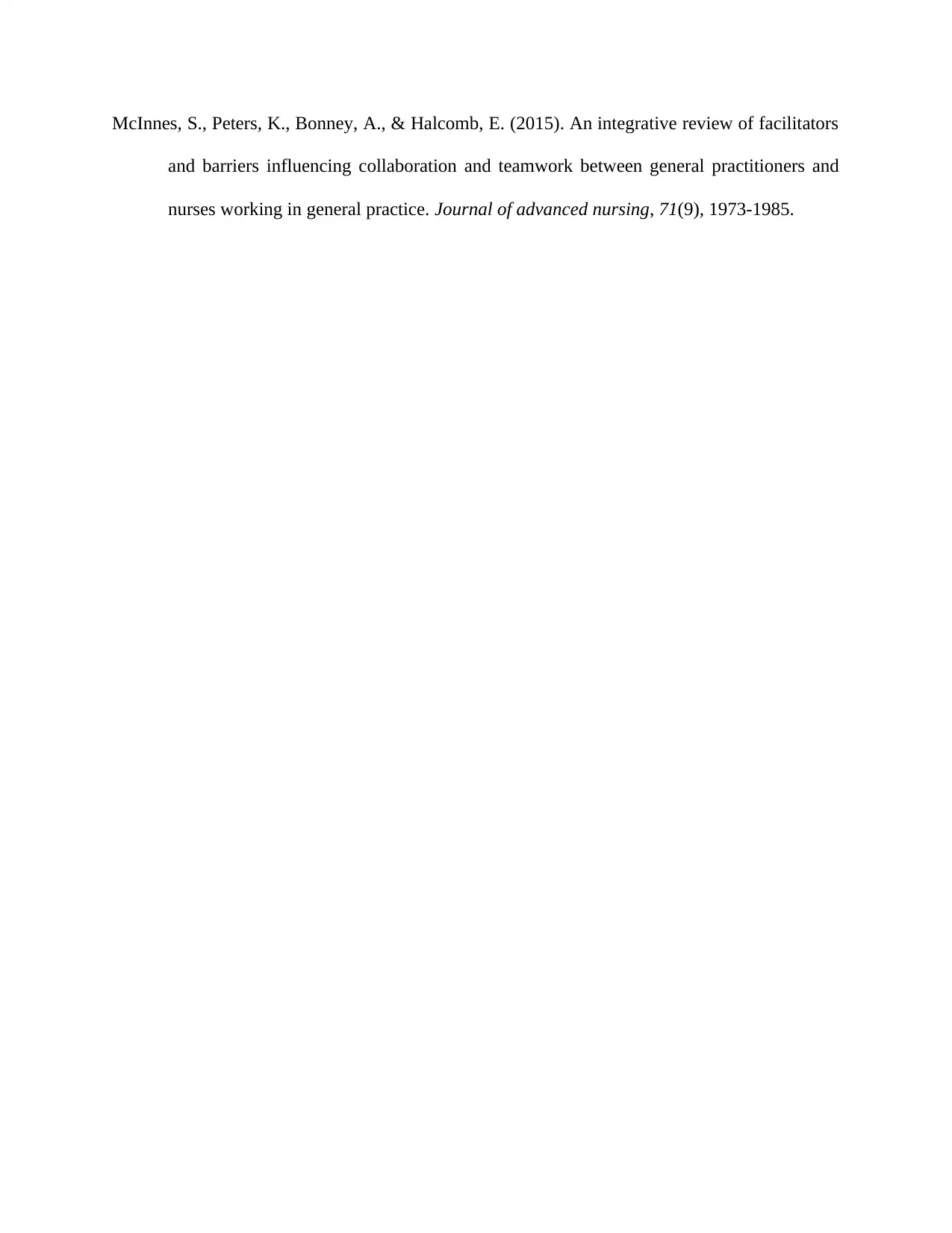
McInnes, S., Peters, K., Bonney, A., & Halcomb, E. (2015). An integrative review of facilitators
and barriers influencing collaboration and teamwork between general practitioners and
nurses working in general practice. Journal of advanced nursing, 71(9), 1973-1985.
and barriers influencing collaboration and teamwork between general practitioners and
nurses working in general practice. Journal of advanced nursing, 71(9), 1973-1985.
⊘ This is a preview!⊘
Do you want full access?
Subscribe today to unlock all pages.

Trusted by 1+ million students worldwide
1 out of 6
Related Documents
Your All-in-One AI-Powered Toolkit for Academic Success.
+13062052269
info@desklib.com
Available 24*7 on WhatsApp / Email
![[object Object]](/_next/static/media/star-bottom.7253800d.svg)
Unlock your academic potential
Copyright © 2020–2025 A2Z Services. All Rights Reserved. Developed and managed by ZUCOL.




